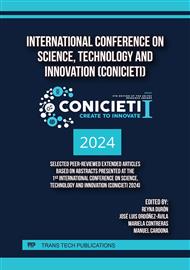[1]
Backus, J. (1978). Can programming be liberated from the von Neumann style? A functional style and its algebra of programs. Communications of the ACM, 21(8), 613-641.
DOI: 10.1145/359576.359579
Google Scholar
[2]
Shalf, J. (2020). The future of computing beyond Moore's Law. Philosophical Transactions of the Royal Society A, 378(2166), 20190061.
DOI: 10.1098/rsta.2019.0061
Google Scholar
[3]
Dennard, R. H., Cai, J., & Kumar, A. (2018). A perspective on today's scaling challenges and possible future directions. In Handbook of Thin Film Deposition (pp.3-18). William Andrew Publishing.
DOI: 10.1016/b978-1-4377-7873-1.00001-2
Google Scholar
[4]
Kim, M. S., Kim, M. S., Lee, G. J., Sunwoo, S. H., Chang, S., Song, Y. M., & Kim, D. H. (2022). Bio‐inspired artificial vision and neuromorphic image processing devices. Advanced Materials Technologies, 7(2), 2100144.
DOI: 10.1002/admt.202100144
Google Scholar
[5]
Blouw, P., & Eliasmith, C. (2020, May). Event-driven signal processing with neuromorphic computing systems. In ICASSP 2020-2020 IEEE International Conference on Acoustics, Speech and Signal Processing (ICASSP) (pp.8534-8538). IEEE.
DOI: 10.1109/icassp40776.2020.9053043
Google Scholar
[6]
Aitsam, M., Davies, S., & Di Nuovo, A. (2022). Neuromorphic computing for interactive robotics: a systematic review. Ieee Access, 10, 122261-122279.
DOI: 10.1109/access.2022.3219440
Google Scholar
[7]
Mitchell, J. P., Bruer, G., Dean, M. E., Plank, J. S., Rose, G. S., & Schuman, C. D. (2017, October). NeoN: Neuromorphic control for autonomous robotic navigation. In 2017 IEEE International Symposium on Robotics and Intelligent Sensors (IRIS) (pp.136-142). IEEE.
DOI: 10.1109/iris.2017.8250111
Google Scholar
[8]
Canales-Verdial, J. I., Wagner, J. R., Schmucker, L. A., Wetzel, M., Proctor, P., Carson, M., ... & Zarkesh-Ha, P. (2024). Energy-Efficient Neuromorphic Architectures for Nuclear Radiation Detection Applications. Sensors, 24(7), 2144.
DOI: 10.3390/s24072144
Google Scholar
[9]
Kulkarni, M. S., & Teuscher, C. (2012, July). Memristor-based reservoir computing. In Proceedings of the 2012 IEEE/ACM International Symposium on Nanoscale Architectures (pp.226-232).
DOI: 10.1145/2765491.2765531
Google Scholar
[10]
Li, Y., Wang, Z., Midya, R., Xia, Q., & Yang, J. J. (2018). Review of memristor devices in neuromorphic computing: materials sciences and device challenges. Journal of Physics D: Applied Physics, 51(50), 503002.
DOI: 10.1088/1361-6463/aade3f
Google Scholar
[11]
Hong, Q., Zhao, L., & Wang, X. (2019). Novel circuit designs of memristor synapse and neuron. Neurocomputing, 330, 11-16.
DOI: 10.1016/j.neucom.2018.11.043
Google Scholar
[12]
Danilin, S. N., Shchanikov, S. A., Zuev, A. D., Bordanov, I. A., & Sakulin, A. E. (2019, October). The research of fault tolerance of memristor-based artificial neural networks. In 2019 12th International Conference on Developments in eSystems Engineering (DeSE) (pp.539-544). IEEE.
DOI: 10.1109/dese.2019.00104
Google Scholar
[13]
Aguirre, F., Sebastian, A., Le Gallo, M., Song, W., Wang, T., Yang, J. J., ... & Lanza, M. (2024). Hardware implementation of memristor-based artificial neural networks. Nature Communications, 15(1), 1974.
Google Scholar
[14]
Liu, C., Hu, M., Strachan, J. P., & Li, H. (2017, June). Rescuing memristor-based neuromorphic design with high defects. In Proceedings of the 54th Annual Design Automation Conference 2017 (pp.1-6).
DOI: 10.1145/3061639.3062310
Google Scholar
[15]
Zhou, W., Wen, S., Liu, Y., Liu, L., Liu, X., & Chen, L. (2023). Forgetting memristor based STDP learning circuit for neural networks. Neural Networks, 158, 293-304.
DOI: 10.1016/j.neunet.2022.11.023
Google Scholar
[16]
Ben Dayan Rubin, D. D., & Fusi, S. (2007). Long memory lifetimes require complex synapses and limited sparseness. Frontiers in computational neuroscience, 1, 117.
DOI: 10.3389/neuro.10.007.2007
Google Scholar
[17]
Woods, W., Bürger, J., & Teuscher, C. (2015). Synaptic weight states in a locally competitive algorithm for neuromorphic memristive hardware. IEEE Transactions on Nanotechnology, 14(6), 945-953.
DOI: 10.1109/tnano.2015.2449835
Google Scholar
[18]
Rozell, C. J., Johnson, D. H., Baraniuk, R. G., & Olshausen, B. A. (2008). Sparse coding via thresholding and local competition in neural circuits. Neural computation, 20(10), 2526-2563.
DOI: 10.1162/neco.2008.03-07-486
Google Scholar
[19]
Li, C., Belkin, D., Li, Y., Yan, P., Hu, M., Ge, N., ... & Xia, Q. (2018). Efficient and self-adaptive in-situ learning in multilayer memristor neural networks. Nature communications, 9(1), 2385.
DOI: 10.1038/s41467-018-04484-2
Google Scholar
[20]
Yu, Y., Adu, K., Tashi, N., Anokye, P., Wang, X., & Ayidzoe, M. A. (2020). Rmaf: Relu-memristor-like activation function for deep learning. IEEE Access, 8, 72727-72741.
DOI: 10.1109/access.2020.2987829
Google Scholar
[21]
NNDC | National Nuclear Data Center. (n.d.). Retrieved April 27, 2024, from https://www.nndc.bnl.gov/
Google Scholar
[22]
Tuli, J. K. (2004). Nuclear wallet cards for radioactive nuclides. Brookhaven National Laboratory, Upton, New York, USA.
Google Scholar



